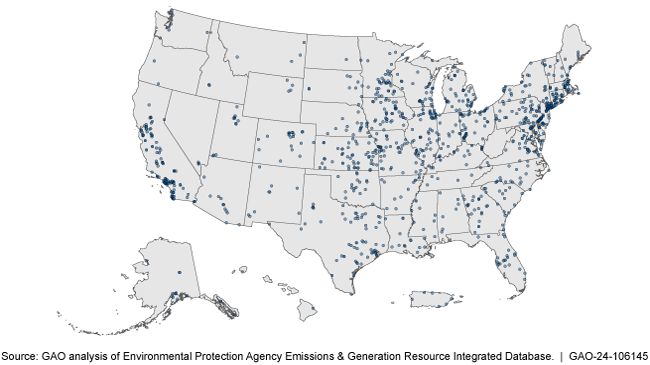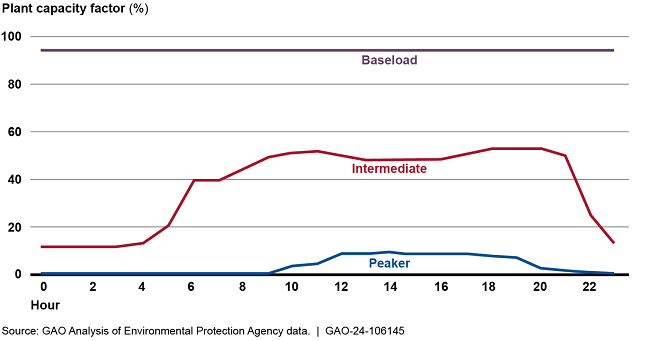Electricity: Information on Peak Demand Power Plants
Fast Facts
This Q&A report explores peak demand power plants—known as "peakers"—that supplement other types of power plants and operate when power demand is greatest, e.g., hot summer afternoons. Peakers tend to be located near historically disadvantaged communities.
Natural gas fuels most of the 999 peakers in the United States. Like other power plants, peakers emit several pollutants, such as sulfur dioxide—which can lead to breathing problems. Peakers operate less often but have higher emission rates. Replacing fossil-fueled peakers with alternatives like battery storage systems may help decrease emissions but cost and reliability may pose challenges.
Map of Peaker Power Plants in the U.S., as of 2021

Highlights
What GAO Found
Peak demand power plants, known as peakers, are part of the U.S. energy infrastructure. They generally operate at times during the day when cooling and heating needs are the highest among households. Peakers are used to supplement other types of power plants, such as baseload and intermediate plants that supply a more consistent amount of electricity to meet demand throughout the day.
Example of Annual Average Hourly Capacity Factors by Plant Type

Note: A plant’s capacity factor is the percent of energy produced of the total energy that could have been produced at continuous full power operation during a certain time frame.
There were 999 peakers in the U.S. in 2021, according to GAO's analysis of the most recent Environmental Protection Agency (EPA) data. Most of these peakers were fueled by natural gas. In 2021, peakers accounted for 3.1 percent of annual net electricity generation and 19 percent of total designed full-load sustained output for all power plants.
Peakers, and other plants, emit multiple pollutants associated with various negative health effects for the people exposed, according to EPA data and GAO's review of selected studies. For instance, short-term exposure to sulfur dioxide, which peakers emit, can lead to harmful respiratory effects, such as decreased lung function, cough, chest tightness, and throat irritation.
Using a statistical analysis, GAO found that historically disadvantaged communities (i.e., census tracts with higher percentages of historically disadvantaged racial or ethnic populations) are associated with being closer to peakers. For example, based on GAO's model, a community that is 71 percent historically disadvantaged is expected to be 9 percent closer to the nearest peaker than a community that is 40 percent historically disadvantaged. In addition, the model showed the estimated distance to the nearest peaker varies according to population density. Urban communities have smaller estimated distances to the nearest peaker compared with similar rural or suburban communities.
When operating, peakers emit pollutants like those from other power plants that use fossil fuels, such as nitrogen oxides and sulfur dioxide. According to EPA data, peakers operate less frequently overall than non-peakers, but when they do operate, they emit more pollution. For example, peakers' total annual sulfur dioxide emissions were 96.8 percent lower than non-peakers, but the median peaker emitted 1.6 times more sulfur dioxide per unit of electricity generated than the median non-peaker. This increase may occur because peakers may not have effective, if any, emissions control technology.
Available alternatives, such as battery storage systems, could replace fossil-fueled peakers and decrease associated emissions. However, replacing peakers with alternatives has potential challenges including cost, reliability, and location, according to studies and stakeholders GAO interviewed.
Why GAO Did This Study
Environmental advocacy groups, and some congressional leaders have expressed concerns that peakers may be less efficient than non-peakers, meaning peakers may expend more energy that is not converted into electricity than other types of plants. Further, due to the nature of their operations, peakers may also negatively affect the air quality in communities around the plants, which may be historically disadvantaged or disproportionately low-income.
GAO was asked to examine pollution from peakers across the nation. This report provides information on the number and location of peakers in the U.S., their proximity to historically disadvantaged or disproportionately low-income communities, to what extent they emit pollutants and how these pollutants affect the health of people exposed, and alternatives for replacing them. To perform this work, GAO analyzed data from EPA, the U.S. Department of Energy, and other sources, reviewed relevant literature, and interviewed federal officials and stakeholders from 19 state, industry, and nongovernmental organizations representing a diversity of perspectives about peakers.
For more information, contact Frank Rusco at 202-512-4598 or ruscof@gao.gov.
